we do NOT currently run this tour
this page provides background information
about Western Tibet.
revision 21jan09
http://www.greenkiwi.co.nz/footprints/frames/ka.htm
PRINT VERSION
In 2011 we shall once again take a group to the Kailas region of Tibet.
That tour is detailed on the Kailas: Art of Western Tibet page.
What follows is an account of a tour in 2001.
We have now taken seven groups into this very unique region.
There are differences between this tour and the 'Art' tour, please compare and
please contact us with your interest or queries.
 The Geography
The Geography In shape it resembles a vast cathedral......the sides of the mountain are perpendicular and fall sheer for hundreds of feet, the strata horizontal, the layers of stone varying slightly in colour, and the dividing lines showing up clear and distinct......which give to the entire mountain the appearance of having been built by giant hands, of huge blocks of reddish stone. The Great Plateau,
Capt. C.G. Rawling, London, 1905
Immediately to the south between Kailas and the
main Himalaya are two large lakes, Manasrovar and Rakshas Tal. The largest,
Manasarovar is regarded as the highest body of fresh water in the world.
Far beneath us, some miles away, lay the most brilliantly beautiful blue sea, the celebrated Manasoraovar lake........ The foreground was flat, rolling hills and ridges sloping gradually towards the lake, all bare and tinted in the most crude colours - reds and pinks and orange - while hundreds of miles to the north and west in the violet distance there stretched range after range of low, jagged hills, all alike, and succeeding one another in endless succession. Conspicuous, and towering above them all, was the snow-capped summit of the Sacred Kailas.
In the Forests of Upper India,
Thos.W. Webber, London 1902
That this combination of lake and mountain, a source of great rivers, remote and beautiful should be regarded as special is not remarkable. In fact Manasarovar and Kang Rimpoche, ‘Precious Jewel of the Snow’ and Tibetan name for Kailas, have been a site of pilgrimage for thousands of years. From all parts of India; from the Himalayan kingdoms of Sikkim, Bhutan, Nepal, Ladakh and Kashmir; from every quarter of Tibet and from the hinterlands of Central Asia many thousands of pilgrims have made the arduous journey.
Just as a white summer cloud, in harmony with heaven and earth freely floats in the blue sky from horizon to horizon following the breath of the atmosphere - in the same way the pilgrim abandons himself to the breath of the greater life that...leads him beyond the farthest horizons to an aim which is already present within him, though yet hidden from his sight.
The Way of the White Clouds,
Lama Govinda, Hutchinson, 1966
The Religious Associations,
of Kailas and Manasrovar
Hindus regard Mt Kailas as the earthly manifestation
of Mt Meru, their spiritual centre of the universe, a "world pillar’ 84,000
miles high around which all else revolves. On the summit sits Lord Shiva who
shares this lofty peak with his consort Parvati, daughter of Himalaya. Below,
Manasarovar floats in the shadow of holy Kailas as the lake formed in the mind
of God. It was created to show the omnipotence of Brahma’s mind (manas).
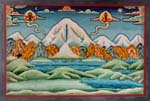 To bathe in the lake and to drink its waters is to be delivered to the paradise
of Brahma and to cleanse the sins of a hundred lifetimes. Lying as they do beneath
the symbolic temple of Kailas, Manasrovar and Rakshas Tal represent the water
tanks present at the entrance to every Hindu temple. The round shape of the
former is like the sun and the curved outline of Rakshas Tal symbolises the
moon. These ideas are expressed in the names of the two lakes, Manasrovar being
associated with ‘light’ and Rakshas Tal meaning the ‘lake of the demons’. To
Hindus Manasrovar symbolizes the receptive, female aspect of creation, the yoni;
while Mt Kailas symbolizes the active male aspect, the lingam. In 1948 some
of Mahatma Gandhi’s ashes were ceremonially scattered on the holy lake.
To bathe in the lake and to drink its waters is to be delivered to the paradise
of Brahma and to cleanse the sins of a hundred lifetimes. Lying as they do beneath
the symbolic temple of Kailas, Manasrovar and Rakshas Tal represent the water
tanks present at the entrance to every Hindu temple. The round shape of the
former is like the sun and the curved outline of Rakshas Tal symbolises the
moon. These ideas are expressed in the names of the two lakes, Manasrovar being
associated with ‘light’ and Rakshas Tal meaning the ‘lake of the demons’. To
Hindus Manasrovar symbolizes the receptive, female aspect of creation, the yoni;
while Mt Kailas symbolizes the active male aspect, the lingam. In 1948 some
of Mahatma Gandhi’s ashes were ceremonially scattered on the holy lake.
There is no mountain like Himalchal, for in it are Kailas and Mansarovar. As the dew is dried up by the morning sun, so are the sins of the world dried up at this sight of Himachal.
The Ramayana
For the Jains, Kailas is acclaimed as the site where
their first prophet achieved enlightenment.
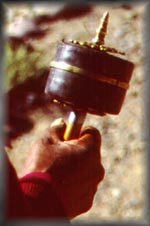
![]()
The land of origin of the pre-Buddhist Bon-pos, it is
the site where their founder Shenrab descended from heaven and is the spiritual
centre of the ancient Bon empire which once included all of western Tibet. Mt
Kailas is their soul mountain. They also call it ‘nine-storey swastika mountain’,
thus describing the mountain’s prominent markings and recalling that the swastika
is an ancient Asian symbol. When a Buddhist revival embraced this area from
Ladakh in the tenth century it absorbed many of Bon traditions. The Bon-pa also
circumambulate Mt Kailas but in their traditional anti-clockwise manner, opposite
to Buddhists and Hindus.
![]()
Mt Kailas is known to the Tibetans as Kang Rimpoche,
‘Precious Jewel of the Snow’. Like the Hindus, Tibetan Buddhists recognise Mt
Kailas as the manifestation of Mt Meru, the ‘navel of the world’, rising ‘like
the handle of a mill-stone’ into the heavens. It is said that from the slopes
of Mt Meru a stream flows into Manasarovar and from this lake four mythical
rivers flow in the four cardinal directions to the ocean. These rivers are now
associated with the four major rivers originating near here; the Indus, Tsangpo,
Karnali and Sutlej.
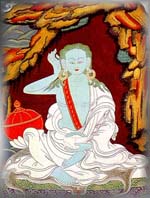 Manasarovar, Tibetans know as Mapham Tso, the ‘Unconquerable Lake’. The name
records a magical contest between the Tibetan poet and mystic Milarepa, and
the Bon priest Naro Bhun Chon which occurred here in the tenth century. Their
tussles are marked in numerous sites around the region. In any language it is
the holiest most famous lake in Asia. For Tibetans, Mt Kailas is the mythical
palace of Demchok, the powerful Tibetan tutelary deity who ‘tears asunder the
elephant-hide of ignorance’ and his consort Dorje Phagmo. The two symbolise
compassion and wisdom, making Kailas and Manasarovar the perfect complement:
father and mother of the earth.
Manasarovar, Tibetans know as Mapham Tso, the ‘Unconquerable Lake’. The name
records a magical contest between the Tibetan poet and mystic Milarepa, and
the Bon priest Naro Bhun Chon which occurred here in the tenth century. Their
tussles are marked in numerous sites around the region. In any language it is
the holiest most famous lake in Asia. For Tibetans, Mt Kailas is the mythical
palace of Demchok, the powerful Tibetan tutelary deity who ‘tears asunder the
elephant-hide of ignorance’ and his consort Dorje Phagmo. The two symbolise
compassion and wisdom, making Kailas and Manasarovar the perfect complement:
father and mother of the earth.
After traversing the difficult passes across the snowy range and the inclement table-land of Tibet, they discovered the group of mountains called Kailas, and the lakes from which flowed forth the great rivers to water and give life to the whole earth. The rugged grandeur of the scene, the awful solitude and the trials and dangers of the way itself naturally suggested to an imaginative and simple people that they had at length rediscovered the golden land, the true home of their gods......
E.T. Atkinson, Himalayan Gazeteer
Early Europeans
![]()
he first westerners to set eyes on the sacred mountain were the Jesuit missionaries Ippolito Desideri and Manuel Freyre who passed this way en-route to Lhasa from Ladakh in 1715. They were not impressed.........
Close by is a mountain of excessive height and great circumference, always enveloped in cloud, covered with snow and ice, and most horrible, barren, steep and bitterly cold.
The Travels of Ippolito Desideri of Pistoia, S.J., 1712-21,
F. de Filippi ed., London 1937
The first Britisher to see Mt Kailas was a veterinarian from
Lancashire, William Moorcroft. Ruined by speculation in a scheme to manufacture
horseshoes by machinery he came to India to work for the East India Company.
Interested to improve the quality of the Company’s horses with Central Asia
stock he came to the region in 1818. His journey was beset with problems with
the local Tibetan and Nepalese authorities so he was not able to import any
animals or establish trade routes.
A trickle of foreign travellers continued during the second half of the nineteenth
century. Amongst them were several ‘sportsmen’ seeking to collect trophies amongst
the herds of wild yak, kyang and antelope which grazed the high plains.
And, representatives from the British administration of India came from time
to time to pay their respects to the Tibetan authorities. Some really felt at
home with the Tibetans, but most were delighted to return home after a sojourn
on the plateau.

....we could not but help comparing this homely sight (villages & trees) with what we had just left behind on the other side of the great barrier of the Himalayas, where desolation is boldly written across treeless landscape, where, with few exceptions, cultivation is unknown, and a nomad population living in tents is so scattered over the barren wilderness that the traveler can travel for days and see no human being, while the absence of houses makes desolation more desolate.
Western Tibet and the British Borderland,
C.A.Sherring, London, 1906
It was not until the twentieth century that the first westerner made the parakrama or circumambulation of Mt Kailas. This honor fell to Sven Hedin the Swedish adventurer and explorer. Driven by a thirst for heroic achievement Hedin endured great hardships crossing the Chang Thang (northern plain), at one time traveling for eighty days without sight of other humans. Of the parikrama he said....
Our wanderings round Kang-rinpoche, the ‘holy ice mountain’ or the ‘ice jewel’ is one of my most memorable recollections in Tibet, and I quite understand how the Tibetans can regard as a divine sanctuary this wonderful mountain which has so striking resemblance to a chorten, the monument which is erected in memory of a deceased saint within or without the temples. ...From the highlands of Kham in the remotest east, from Naktsang and Amdo, from the unknown Bongba, which we have heard only in vague reports, from the black tents which stand like the spots of a leopard scattered among the drear valleys of Tibet, from Ladak in the south, thousands of pilgrims come hither annually, to pace slowly and in deep meditation the 28 miles round the navel of the earth, the mountain of salvation.
S.Hedin, Transhimalaya, 3vols, London, 1910
Natural hazards and banditry isolated the region from foreign
visitors, allowing the locals a sense of satisfaction with their lofty birthright.
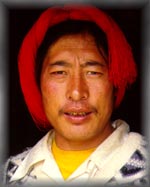
I have seen many Europeans, and many Indians who are ruled by Europeans. They all seemed very unhappy to me. We have our gods and we are content. If the Europeans came, however, they would drive the gods away and bring us nothing in their place. That’s why we prefer to be left alone. In your country, Kashmir, you may be a great lord, a tax collector or a substantial landowner. Here, you are nothing. Even I, the ruler of this whole province, am nothing. Only the gods rule here.
The Garpon of Ngari speaking to a disguised Herbert Tichy,
Tibetan Adventure, H.Tichy, London 1938
![]() he advent of Chinese dominance in the 1950’s fundamentally
changed life in all Tibet. Forced resettlement, government ownership of livestock,
banning the use of Tibetan language in schools and attempts to completely wipe
out the monastic way of life led to much loss of life and caused many to flee
the country. More recently there has been a large influx of Han Chinese into
Tibet so that they now threaten to outnumber ethnic Tibetan citizens.
he advent of Chinese dominance in the 1950’s fundamentally
changed life in all Tibet. Forced resettlement, government ownership of livestock,
banning the use of Tibetan language in schools and attempts to completely wipe
out the monastic way of life led to much loss of life and caused many to flee
the country. More recently there has been a large influx of Han Chinese into
Tibet so that they now threaten to outnumber ethnic Tibetan citizens.
During the Cultural Revolution in the 60’s most of the country’s shrines and
monasteries were systematically plundered and dynamited by the Chinese. Despite
its remote location and harsh climate, Ngari did not escape these upheavals.
Most of the ancient monasteries suffered damage or were totally destroyed. There
have been attempts to right some of these wrongs, nevertheless Tibetans remain
second class citizens in their own country. Reconstruction of shrines and temples
has been carried out but it is impossible to replace paintings and statues of
antiquity and the harm done to the monastic way of life is possibly irreparable.
 Until 1986 only a handful of Western travellers had made the arduous journey
to the holy mountain. In that year the Chinese authorities allowed foreigners
to travel there by road. However, political uncertainties together with the
expense and length of the journey meant that only a few score of travellers
made the trip. One definite benefit from Chinese hegemony is the absence of
roving dacoits who made travel hazardous for all travellers until very recent
times.
Until 1986 only a handful of Western travellers had made the arduous journey
to the holy mountain. In that year the Chinese authorities allowed foreigners
to travel there by road. However, political uncertainties together with the
expense and length of the journey meant that only a few score of travellers
made the trip. One definite benefit from Chinese hegemony is the absence of
roving dacoits who made travel hazardous for all travellers until very recent
times.
In 1993 authorities allowed trekkers to cross the Nepal border near Kailas thus
making it possible, like the ancients, to walk to the holy mountain. In 1996
permission was given to return by road. It is this route, to and from Nepal,
that we shall take. ![]()
Why Kailas?
To see the greatness of a mountain, one must keep one's distance; to understand its form, one must move around it; to experience its moods, one must see it at sunrise and sunset, at noon, and at midnight, in sun and in rain, in snow and in storm, in summer and in winter and in all the other seasons. He who can see the mountain like this comes near to the life of the mountain, a life that is as intense and varied as that of a human being.Mountains grow and decay, they breathe and pulsate with life. They attract and collect invisible energies from their surroundings: the forces of the air, of the water, of electricity and magnetism; they create winds, clouds, thunderstorms, rains waterfalls, and rivers They fill their surroundings with active life and give shelter and food to innumerable beings. Such is the greatness of mighty mountains....
In the dust-filled valleys and low plains of our daily existence we have forgotten our connections with stars and suns; and therefore we need the presence of these mighty signposts and milestones to shake us up and arouse us from the slumber of self-complacency. Not many are there who hear the call or feel the urge to rise from under their thick blanket of petty self-interests, of money-making or pleasure-hunting, but the few whom the call has reached, and in whom the longing for greater things is still awake, form a steady stream of pilgrims who keep alive the traditions and knowledge of these sources of inspiration.
The Way of the White Clouds,
Lama Govinda,
Hutchinson, 1966
What is trekking?
![]() n 1965 Colonel Jimmy Roberts introduce the world to trekking.
A former Gurkha Officer, Military Attache at the British Embassy in Kathmandu
and logistic advisor to many expeditions he had spent years of his life walking
the hills of Nepal. His idea, revolutionary for the time, was to provide tents
together with Sherpas, to guide and cook. This made Nepal and the Himalaya available
to a wide community and was an immediate success.
n 1965 Colonel Jimmy Roberts introduce the world to trekking.
A former Gurkha Officer, Military Attache at the British Embassy in Kathmandu
and logistic advisor to many expeditions he had spent years of his life walking
the hills of Nepal. His idea, revolutionary for the time, was to provide tents
together with Sherpas, to guide and cook. This made Nepal and the Himalaya available
to a wide community and was an immediate success.
Nowadays the formula is well established; groups travel through the hills, walking
for five to six hours each day with all their equipment carried by porters;
good quality meals are provided along with warm sleeping bags and comfortable
tents; the trekker carries a personal pack with camera, day clothing and snacks.
Walking for days on end might sound daunting, but actually it is not too difficult,
anyone who has tramped the New Zealand hills with their own pack will find Nepalese
trekking much easier, and more stylish! This Footprints trek in Nepal and
Tibet is not easy but it should not prove difficult to fit individuals.
For long miles into the heart of morning,
Miles and miles, far over land and sea,
Past enchanted regions of forewarning,
Dawns at last the land that dims all these.
Jimmy Roberts
How Difficult is
this Trek?
The walking in itself is not particularly difficult. The
main problem is adaptation to altitude. For the most part, the days are not
long, usually five to six hours of walking, starting and finishing early with
lots of time for rests and lunch. However, as you walk up a seemingly endless
hill there is opportunity to reflect on Lord Buddha's first noble truth, that
suffering exists! Apart from fitness, the most important attribute is right
attitude. In addition to the two main walking segments, there will be opportunitys
to walk off or along the road. These road-walks are through spectacular terrain
with scanty to non-existant vehicular traffic.
There are two main walking segments as follows:
Being fit for the trek is essential. Without a good level of tramping fitness it would be not only painful, but foolish to embark on this expedition. Each day on the trek you will carry only a day-pack and yourself. How well you prepare each of these is definitely a personal matter.
Trek Difficulty Trek Segment Trek Difficulty Altitude Simikot to Tibet: moderate 2900 - 4580m
(9,500 - 15,000 feet)
mostly around 3,000m
with two days above 4,300m
Around Mt Kailas: moderate to difficult 4600 - 5670m
(15,000 - 18,500 feet)
mostly around 4,800m
with two days above 5,000m
What about Altitude?
This is much more difficult to assess. Adaptation to altitude
depends very much on the speed at which altitude is reached. It has little relationship
to fitness and no relationship to age. At altitude I have seen many examples
of fit 70 year olds out-performing youngsters less than half their age.
If you have previously trekked to altitude, and your ascent at that time was
gradual, your experiences on this trek are likely to be similar. If you have
had a bad experience you have to question whether your approach was sufficiently
gradual or whether you might be a person who just does not do well at rarefied
heights. If you have qualms or queries about this, I am happy to discuss it
with you.
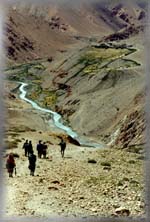 I have been taking trekkers to Nepal since 1978 and have never had anyone seriously
ill with altitude. The important things are to have gradual ascent, time to
adjust, rest days, and someone who can recognise early problems. All these requirements
are features of this tour or indeed, any Footprints trip. We have structured
this trip to be gradual. The tour is longer than offerings by other companies
to allow time for rest days and acclimatization. During our previous Kailas
treks no member of the group experienced other than minor altitude symptoms.
I have been taking trekkers to Nepal since 1978 and have never had anyone seriously
ill with altitude. The important things are to have gradual ascent, time to
adjust, rest days, and someone who can recognise early problems. All these requirements
are features of this tour or indeed, any Footprints trip. We have structured
this trip to be gradual. The tour is longer than offerings by other companies
to allow time for rest days and acclimatization. During our previous Kailas
treks no member of the group experienced other than minor altitude symptoms.
People respond differently to altitude however, so on this trek if someone is
not acclimatizing well then alternatives will be arranged. ![]()
![]()
How Many people
will go on this trek?
The minimum client numbers for this trip is 6, maximum
12. ![]()
![]()
What other information
will you send me?
After registration I shall send you masses of pre-trek information including; a daily trek itinerary; detailed information about what you need to prepare and bring for this trek; a suggested reading list; information relating to health issues and vaccinations.
How do we travel
in Tibet?
Because the roads are too rough for buses, when not walking,
we shall be driven around in Land Cruiser type vehicles. Our Nepal Sherpas will
accompany us into Tibet to provide trek and camping assistance. ![]()
![]()
What about the weather?
We shall be traveling at the preferred time for Tibet.
Late August is the end of the rainy season when roads are open and the weather
is likely to be most stable.
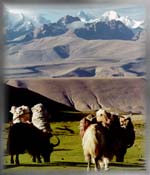
...Then one morning we would find the snow-clouds passed away, and see the great peak of Chumalhari emerging calm, strong, and irresistible from out of the mass of cloud still tossing wildly round its base... and above it lay the calm blue sky, illimitable in its restfulness and light - a sky of bright and liquid azure, through which one seemed able to pierce right into heaven itself.
Sir Francis Younghusband
India and Tibet, London 1910
In Tibet however, as in any mountain region, rain and snow showers can occur at any season. By contrast, the lower regions of Nepal will be hot and humid with daily rain showers interspersed with brilliant sunshine.
Next day there was humid sun and shifting southern skies, but to the north a deep tumult of swirling greys was all that could be seen of the Himalaya. ...Then four miles above these mud streets of the lowlands, at a point so high as to seem overhead, a luminous whiteness shone - the light of snows. Glaciers loomed and vanished in the greys, and the sky parted, and the snow cone of Machhapuchare glistened like a spire of a higher kingdom.
The Snow Leopard, Peter Matthiessen
The General Plan
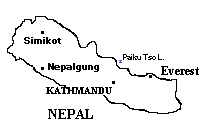 trek for six days to Tibet; visit the holy lake of Manasarowar; explore the nearby
ancient monastic towns of Tholing and Tsaparang; then circumambulate Kailas and
return to Kathmandu by driving the 'Southern Highway'.
trek for six days to Tibet; visit the holy lake of Manasarowar; explore the nearby
ancient monastic towns of Tholing and Tsaparang; then circumambulate Kailas and
return to Kathmandu by driving the 'Southern Highway'.
To Simikot
It is a two hour flight from Kathmandu to Nepalgung a
southern border town on the Terai in the far west of Nepal. This Terai land
is flat low-altitude country, barely 200m above sealevel, yet more than 1,200Km
from the sea. We shall try to fly by helicopter, directly north to Simikot,
administrative center for Humla district, the most remote in Nepal. Circumstances
might dictate that we overnight in Nepalgang. At Simikot we shall be met by
our Sherpa trekking crew. After sorting supplies and making the necessary overtures
to the police we set out on trek.
![]()
![]()
Into Tibet
It is a six day trek to the Tibetan border. For most of
the journey we follow the valley of the Humla Karnali, traversing side ridges
up and down as we gradually gain altitude.
Our flight has taken us through the main Himalaya so, although it is the monsoon,
we shall be in the 'rain shadow' of the mountains with hopefully little precipitation
and a good chance of clear mountain views especially in the early mornings.
To the south are the some notable Himalayan giants, Saipal 7031m and Api 7132m
but our views are likely to be confined to smaller mountains north of the valley.
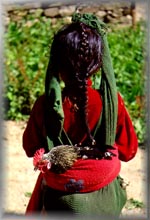 This is a lovely trek through varied terrain. Initially, there are significant
forests but as we head north the land becomes more arid with sparse vegetation.
People in these high valleys grow barley and buckwheat with only one crop each
year possible because of the severe winters when snow lies deeply throughout
the region. There are orchards of apricot and apple and constant herds of goats
contributing to the deforestation which is a problem throughout the entire Himalaya.
Numerous, small and flat-roofed villages become more spartan as we ascend towards
the Nara Lagna pass (4580m). On our last day in Nepal we cross the Lipu Lekh,
an outlier of the main Himalayan chain and descend to the Tibetan border, a
bridge crossing the Karnali river. From
here it is a short drive to Purang, the main administrative town for the region.
For administrative reasons we spend the night here in a guest house.
This is a lovely trek through varied terrain. Initially, there are significant
forests but as we head north the land becomes more arid with sparse vegetation.
People in these high valleys grow barley and buckwheat with only one crop each
year possible because of the severe winters when snow lies deeply throughout
the region. There are orchards of apricot and apple and constant herds of goats
contributing to the deforestation which is a problem throughout the entire Himalaya.
Numerous, small and flat-roofed villages become more spartan as we ascend towards
the Nara Lagna pass (4580m). On our last day in Nepal we cross the Lipu Lekh,
an outlier of the main Himalayan chain and descend to the Tibetan border, a
bridge crossing the Karnali river. From
here it is a short drive to Purang, the main administrative town for the region.
For administrative reasons we spend the night here in a guest house.
Such houses and such men, ragged, tough and cheerful, both alike reeking of juniper smoke, speak of high valleys upon the threshold of high mountains.
H.W. Tilman, in the Marsyandi Valley, 1949
Lake Manasarovar
Beyond Purang there are expansive views of the Indian Himalaya.
We are now in Ngari, the western region of Tibet. Remote and sparsely populated,
Ngari stretches more than a thousand kilometres north-westward. On this high
plateau live the Drokpa, Tibet's sturdy nomads. Only they and their scattered
herds roam these high spaces. On reaching the Gurla La (5120m) you can see Lake
Rakshas Tal with sacred Mt Kailas rising above its surrounding girdle of peaks.
It certainly is one of the most inspiring views of this earth, a view, indeed, which makes the beholder wonder whether it is of this world or a dreamlike vision of the next.
The Way of the White Clouds,
Lama Govinda, Hutchinson, 1966
![]()
The road heads down to run along the narrow, hilly finger
of land that separates the two lakes Rakshas Tal and Manasarovar, here less
than four kilometres apart. The holy lake lies above Rakshas Tal by some fifteen
metres. Depending on rainfall, the two are connected by an intermittent stream
the Ganga Chu. Traditionally it is believed that water flowing in this channel
augers well for the Tibetan people.
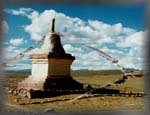 We cross, what is hopefully a briskly flowing stream to to camp beside the lake.
Just above, Chiu (Bird) Gompa, maintains a precarious avian-grip on a steep
cliff with inspired views over the lake to the ice slopes of Gurla Mandhata.
We shall have time for walks and, for the intrepid, a cleansing swim.
We cross, what is hopefully a briskly flowing stream to to camp beside the lake.
Just above, Chiu (Bird) Gompa, maintains a precarious avian-grip on a steep
cliff with inspired views over the lake to the ice slopes of Gurla Mandhata.
We shall have time for walks and, for the intrepid, a cleansing swim.
![]()
![]()
To Tirthapuri and
Gurugem
From Lake Manasrowar it is a two day drive to the fantastically
eroded gorge country of the upper Sutlej. We cross the vast plain of Barkha
with thousand of yak; and on through nomad encampments in a landscape of astonishing
space where the lime-green plain and azure sky merge on the road ahead.
 We dirvert to the famous pilgrimage site of Tirthapuri. Made holy by Guru Rimpoche
who spent time here and accomplished various miracles it is also noted for its
hot springs and a geyser with white and pink terraces. A pilgrimage to Mt Kailas
is considered unfinished unless this place is visited, and anyway, how could
Kiwis not make a visit to 'pink and white terraces'? At a lovely campsite beside
a stream, pilgrims stroll beneath waves of prayer flags. It all so tres photogenic
and fun that we shall spend one night here and another nearby at Gurugem, where
an ancient cave houses the most active Bon-po gompa in western Tibet.
We dirvert to the famous pilgrimage site of Tirthapuri. Made holy by Guru Rimpoche
who spent time here and accomplished various miracles it is also noted for its
hot springs and a geyser with white and pink terraces. A pilgrimage to Mt Kailas
is considered unfinished unless this place is visited, and anyway, how could
Kiwis not make a visit to 'pink and white terraces'? At a lovely campsite beside
a stream, pilgrims stroll beneath waves of prayer flags. It all so tres photogenic
and fun that we shall spend one night here and another nearby at Gurugem, where
an ancient cave houses the most active Bon-po gompa in western Tibet.
![]()
![]()
to Tholing and Tsaparang
It was here, in the gorge country of the Sutlej that the
small kingdom of Gu-ge was established around 900CE. A young monk from this
region spent seventeen years in India becoming possibly the greatest Tibetan
translator of Sanskrit texts. After his return, Rinchen Zangpo was responsible
for the construction of over one hundred monasteries in western Tibet. In 1042
Atisha, the famed Indian Buddhist teacher came to Tholing, the current capital
and composed his most famous work The Lamp for the Path to Enlightenment. Gu-ge
flourished for more than five hundred years, attracting gifted teachers,
artists and scholars from India, Kashmir and Tibet. With the support of sympathetic
rulers, it was their efforts which were responsible for the flowering of Tibetan
Buddhist culture and its expansion throughout Tibet, Nepal and Bhutan.
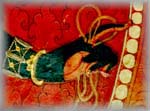 By the 18th century both cities were virtually deserted following a series of
calamities. Smallpox, invasion from Kashmir and a decline in rainfall throughout
the whole region with progressive desertification caused the citizens to leave.
When Lama Govinda and his wife Li Gotami arrived in 1948 they found a single
impoverished caretaker at Tsaparang.
By the 18th century both cities were virtually deserted following a series of
calamities. Smallpox, invasion from Kashmir and a decline in rainfall throughout
the whole region with progressive desertification caused the citizens to leave.
When Lama Govinda and his wife Li Gotami arrived in 1948 they found a single
impoverished caretaker at Tsaparang.
Despite the desecration which took place during the cultural revolution, buildings
and temples remain and many works of art are still preserved at both sites.
Tsaparang in particular was spared annihilation. Its artistic treasures are
relics of an astonishing museum containing some of Asia's most beautiful murals.
We have two days at these twin towns before returning to the holy mountain.
to Dunkar and Piyang
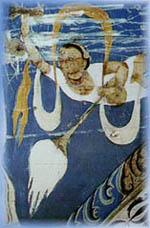 A
few hours from Toling are the ancient troglodyte settlements of Dunkar and Piyang.
Here, literally hundreds of cave-homes pepper the cliffside. Several of these
contain stunning paintings reminiscent of those in the deserts of Xinjiang two
thousand kilometres to the north. This extensive cave complex was thought byTucci,
in 1935, to contain the finest paintings in the region. The overall blue colouration
and the extensive use of flying apsaras ['angels'] clad in diaphanous
gowns is very reminiscent of caves at Dunhuang. The Dongkar and Piyang caves
are possibly the earliest Gu-ge murals in the region.
A
few hours from Toling are the ancient troglodyte settlements of Dunkar and Piyang.
Here, literally hundreds of cave-homes pepper the cliffside. Several of these
contain stunning paintings reminiscent of those in the deserts of Xinjiang two
thousand kilometres to the north. This extensive cave complex was thought byTucci,
in 1935, to contain the finest paintings in the region. The overall blue colouration
and the extensive use of flying apsaras ['angels'] clad in diaphanous
gowns is very reminiscent of caves at Dunhuang. The Dongkar and Piyang caves
are possibly the earliest Gu-ge murals in the region.
[Note: Dongkar image with permission from 'Orientations' magazine, June 1996:
http://www.orientations.com.hk/
and Thomas J. Pritzker, author. ]
to Kailas
Some fit and acclimatised pilgrims can make the 50 kilometre
circle of the mountain in a day. We shall be well acclimatised by now. However,
we are not locals or in such a rush, so we will walk around in four days. This
gives time to contemplate the ever-changing scenic beauty of the mountain, enjoy
the trek at a reasonable pace and make detours. A train of grunting yaks will
take our baggage on what is a walk over predominately easy terrain.
The path follows rolling foothills from Tarchen into the flat green valley of
the Lha Chu. (River of the Gods) Heading north, the view upstream is remarkable.
Red cliffs, interspersed with orange and green strata soar to great heights
on either side. As we pass 'Gold Pot', 'Miracle Spring', 'Horse of Happiness'
and 'Cave of the Female Yak's Horns' we are reminded that this is a pilgrimage
route of the oral tradition, replete with stories.
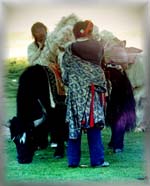 Along the way we shall meet other pilgrims heading in the same clockwise direction.
Those coming towards us are practitioners of Bon, Tibet's most ancient faith.
There may also be the most pious of Tibetan pilgrims, those who circumambulate
the mountain by performing prostration after prostration. Clad in long leather
aprons and leather gloves they take two to three weeks to complete one circuit.
Along the way we shall meet other pilgrims heading in the same clockwise direction.
Those coming towards us are practitioners of Bon, Tibet's most ancient faith.
There may also be the most pious of Tibetan pilgrims, those who circumambulate
the mountain by performing prostration after prostration. Clad in long leather
aprons and leather gloves they take two to three weeks to complete one circuit.
On day three, as we head towards the Drolma La (Pass of the Goddess of Compassion)
we pass Shiwatshal Durtro. The ground here is covered in an incredible assortment
of clothing, bones, saddle bags, hair shoes and endless other objects. All who
pass this place leave something as reminder of the transitory nature of life.
Pilgrims undergo symbolic death at this spot and are reborn at the summit of
the Drolma La. Having paid our dues, we head on past 'White and Black Sin',
'Parent Indemnity Test', 'Sinful Butcher's Hand' and 'Burning Flame Rock.' Living
stories every one!
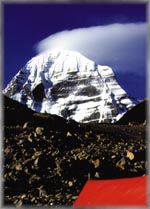 Invoking the goddess will seem a reasonable activity as we toil upward to the
5670m pass, our highest point of the trek. By this time we will have spent more
than three weeks at significant altitude so we should be well acclimatised.
From the pass we head down to the aptly named 'Cave of Miracles', Zuthul-Phuk
our last campsite on the khora. From here it is an easy five hours down the
wide eastern valley to our start point of Tarchen.
Invoking the goddess will seem a reasonable activity as we toil upward to the
5670m pass, our highest point of the trek. By this time we will have spent more
than three weeks at significant altitude so we should be well acclimatised.
From the pass we head down to the aptly named 'Cave of Miracles', Zuthul-Phuk
our last campsite on the khora. From here it is an easy five hours down the
wide eastern valley to our start point of Tarchen.
![]()
![]()
Return from Kailas
We have nine days before returning to Kathmandu.
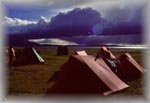 For two nights we shall camp beside Manasarovar on a grassy verge where the
lake-grass and sky-mountain merge.
For two nights we shall camp beside Manasarovar on a grassy verge where the
lake-grass and sky-mountain merge.
 The Southern Highway does little to justify its appelation, but it is marvellously
beautiful and varied, with some exciting river crossings. On the third day we
shall cross the Yarlung Tsangpo, by this stage, so large that we take passage
in a punt. At Pelkhu Tso there is a lake, more intimate than Manas but if anything
more lovely. We shall have a rest day here before heading to Kathmandu, a long
a spectacular descent from the
Tibetan plateau to a more populous and tropical world.
The Southern Highway does little to justify its appelation, but it is marvellously
beautiful and varied, with some exciting river crossings. On the third day we
shall cross the Yarlung Tsangpo, by this stage, so large that we take passage
in a punt. At Pelkhu Tso there is a lake, more intimate than Manas but if anything
more lovely. We shall have a rest day here before heading to Kathmandu, a long
a spectacular descent from the
Tibetan plateau to a more populous and tropical world. ![]()
![]()
Lhasa option
Some may wish to visit Central Tibet and Lhasa. This group will break off after Pelkhu Tso driving on to Lhasa over three days. They will visit Shegar Dzong, 'The White Crystal Castle' and Tashilhumpo, the golden-roofed monastery of the Pachen Lama at Shigatse before reaching Lhasa via Gyantse. Here, at Gyantse the town is dominated by the Kumbum monastery whose eyes.........
Now peaceful, now terrific, seem to jump up alive before your eyes, to crowd on your subconscious so as to haunt your dreams as well. You would think that the painters have by some wizardry conjured up living forces and driven them into their work, and that these could float out of the wall, force their way into your soul and take possession of it by a magic spell.
Guiseppi Tucci, In Secret Tibet.
There are two full days in Lhasa before flying over the Himalaya to Kathmandu.
Visiting Lhasa adds three days to the tour compared to the main group. ![]()
What Else?
![]() ell, it's not just trekking.
ell, it's not just trekking.
Kathmandu
The very first time I went to Nepal I was unprepared for
the great beauty of the Kathmandu valley and stupendous art within the triple
cities of Patan, Bhaktapur and Kathmandu. Kathmandu is a great and safe place
to wander. Artisans over the centuries have adorned the city's temples and houses
creating an open art gallery unlike anywhere else in the world.
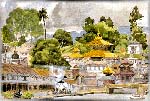 We have five days in Kathmandu to enjoy the crafts, taking the sights and delight
in the myriad of different peoples who look and dress in their own distinctive
tribal style.
We have five days in Kathmandu to enjoy the crafts, taking the sights and delight
in the myriad of different peoples who look and dress in their own distinctive
tribal style.
 We stay at the centrally located Malla Hotel which is quiet and very comfortable,
with a charming garden. Of all the Kathmandu hotels, the Malla has the best
combination of location, charm and cost.
We stay at the centrally located Malla Hotel which is quiet and very comfortable,
with a charming garden. Of all the Kathmandu hotels, the Malla has the best
combination of location, charm and cost. ![]()
![]()
Bangkok
This city has a vibrant culture, superb architecture,
friendly people, great shopping and amazing food. I really enjoy Bangkok, but
it also has heat, humidity and horrendous traffic. At the Menam Hotel on the
banks of the busy Chao Phrya river you can relax or be as active as you wish.
In my experience many trekkers want to travel as directly as possible to and
from Nepal. For this reason we shall overnight in Bangkok going and have one
full day in the city on return.
![]()
![]()
Shopping
There is time in Nepal and Bangkok to shop. Nepal is especially
great for handicrafts such as carving, metalwork, silver jewelry and semiprecious
stones. There are excellent hand-knotted carpets (made with New Zealand and
Tibetan wool) which are an exciting purchase. I shall give indications of costs
and 'best buys' in the trek notes issued to people traveling on the tour.
Bangkok has literally a treasure trove. Exquisite silks, tailoring and designer
clothing are particularly attractive for Kiwis. Local markets are colourful,
safe, have numerous 'finds' and are great fun. ![]()
![]()
Eating
Eating is something that I regard as important for the whole
tour. On trek the meals are substantial and wholesome to replace the energy
lost on the trail.
The cuisine is European with Nepalese overtones. It can be as bland or
as hot as you wish ..and the cook team will always produce something "astonishing".
We shall have our Sherpa staff in Tibet and will take extra food from Nepal
to supplement what is available on the high plateau.
The most important thing about expedition food, is that there should be some!
Wilfred Noyce (after a particularly spartan trip with Eric Shipton in 1951)
In Kathmandu and Bangkok there is opportunity to be more adventurous.
Both cities have excellent restaurants that are inexpensive by New Zealand standards.
While on trek all meals are included. In the cities I make a feature of including
only breakfast in the tour cost. It is my view that prepaid organised meals
are usually inferior to hotel a la carte dining. In addition, organised meals
do not give opportunity to visit local restaurants outside the hotel. Local
restaurants are often more fun, have cheaper and better food, and give an opportunity
to mix with the locals. Don't imagine that Asian food is invariably hot, there
is plenty of restaurant choice in all cities. For those with gourmet tastes
there are particular delights in Bangkok. ![]()
Why
go?
Nepal is there to change you, not for you to change it. Lose yourself in it's essence. Make your footprints with care and awareness of the precarious balance around you. Take souvenirs in you mind and spirit, not in your pockets. Nepal is not only a place on the map, but an experience, a way of life from which we all can learn.
Stephen Bezruchka
A Guide to Trekking in Nepal, 1972
I make a conscious effort with all Footprints treks and tours to realise the spirit of Stephen Bezruchka's words.
Kailas, Land only
group
![]() hose who wish to travel elsewhere in Asia or travel on
to Europe may prefer this option. It includes all accommodation in Kathmandu
with breakfast; Kathmandu tours and other activities as for the main group;
as well as the tour costs, park and trek fees, and visa charges for Tibet.
hose who wish to travel elsewhere in Asia or travel on
to Europe may prefer this option. It includes all accommodation in Kathmandu
with breakfast; Kathmandu tours and other activities as for the main group;
as well as the tour costs, park and trek fees, and visa charges for Tibet.
N.B. If you choose the land-only option please organise your air travel early.
Flights to and from Asia are very heavily booked. I am happy to help with suggestions
and flight bookings if you wish.
Please note: These prices are final for year 2001.
Kailas, to the navel of the world Land Only ex Ktm. May - June 2001 34 day trip 4 nights in Kathmandu 7 day trek in Nepal 23 days in Tibet 6 day jeep trip to Tholing & Tsaparang 2 nights at the pilgrim-hot-springs Tirthapuri & Gurugem 7 day Landcruiser return to Kathmandu 4 day trek around Mt Kailas US$ 6433
for >5-8 clients
[Note: this was the price for 2001. ]US$ 5630
for >9 clients
[Note: this was the price for 2001]
Kailas, Main group
What shall we tell you? Tales, marvellous tales, Of ships and stars and isles where good men rest, Where nevermore the rose of sunset pales, And winds and shadows fall toward the west.
The Golden Journey to Samarkand
James Elroy Flecker
Please note: These prices are final for year 2001.
Kailas, to the navel of the world Main Group ex NZ May to June 2001 38 day trip 4nights in Kathmandu 2nights in Bangkok 7 day trek in Nepal 23 days in Tibet 2 nights at the pilgrim-hot-springs Tirthapuri & Gurugem 6 day jeep trip to Tholing & Tsaparang 4 day trek around Mt Kailas 7 day Landcruiser return to Kathmandu NZ$11,260
final price for > 9 clients
(note: NZ dollars)
[Note: this was the price for 2001]NZ$13,350
final price for 5-8 clients
(note: NZ dollars)
[Note: this was the price for 2001]ex Auckland, Wellington or Christchurch
![]() ome may wish to visit Central Tibet and Lhasa. This group
will break off after Pelkhu Tso driving on to Lhasa over four days. They will
visit Shegar Dzong, ‘The White Crystal Castle’ and Tashilhumpo, the golden-roofed
monastery of the Pachen Lama at Shigatse before reaching Lhasa via Gyantse.
Here, at Gyantse the town is dominated by the Kumbum monastery whose eyes.........
ome may wish to visit Central Tibet and Lhasa. This group
will break off after Pelkhu Tso driving on to Lhasa over four days. They will
visit Shegar Dzong, ‘The White Crystal Castle’ and Tashilhumpo, the golden-roofed
monastery of the Pachen Lama at Shigatse before reaching Lhasa via Gyantse.
Here, at Gyantse the town is dominated by the Kumbum monastery whose eyes.........
Now peaceful, now terrific, seem to jump up alive before your eyes, to crowd on your subconscious so as to haunt your dreams as well. You would think that the painters have by some wizardry conjured up living forces and driven them into their work, and that these could float out of the wall, force their way into your soul and take possession of it by a magic spell.
Guiseppi Tucci, In Secret Tibet.
There are two full days in Lhasa before flying over the
Himalaya to Kathmandu. Visiting Lhasa adds three days to the tour compared to
the main group.
Lhasa option (with Kailas trek) Land only ex Ktm May to June 2001
41 day trip Add US$1048
includes Lhasa/Kathmandu airfare ($288)
[Note: this was the price for 2001]ex New Zealand May to June 2001 42 day trip Add NZ$2278
includes Lhasa/Kathmandu airfare
[Note: this was the price for 2001]
Please note: These prices are final for 2001.![]()
![]()
![]()
Kailas, What do you
get...and, what you don't get?
For all groups
A personally guided introduction to some fabulous people and places with me!
· 1st class twin-share accommodation in all cities · full breakfasts in Kathmandu
and Bangkok · two half day tours in Kathmandu · one half day tour in Bangkok
· a celebratory group dinner in Kathmandu · all transportation within Tibet
and Nepal including flights · Tibet visa and all regional permits · all services
and costs relating to liaison officer in Nepal and Tibet · all transportation,
food and travel costs while on tour.
The following applies to Main Group only
Return economy airfare from Christchurch, Wellington or Auckland to Nepal
· arrival visa in Kathmandu · airport transfers · departure taxes in Bangkok
& Kathmandu · baggage handling on arrival and departure in Bangkok & Kathmandu
The following applies to Tibet option
· ‘best available’ hotel accommodation with all meals between Lake Pelkhu
Tso and Lhasa · entrance fees to monasteries en route to Lhasa · bed/breakfast
accommodation at ‘Lhasa hotel’ (formerly the Lhasa Holiday Inn) · flight Lhasa/Kathmandu
· airport transfers in Lhasa and Kathmandu . all trek and regional permits for
this section of the tour.
What you don't get
NZ departure tax · meals unless stipulated · personal insurance
and medical expenses · emergency evacuation charges (covered by appropriate
medical insurance policy) · excess baggage charges and items of a personal nature
· departure tax in Lhasa ![]()
![]()
![]()
Is it worth it?
![]() believe this trip is excellent value. You are urged to
compare the quality and duration of the experience relative to what is offered
by other companies. There are no hidden expenses here and a lot of extras that
you will not find elsewhere. I have been visiting Nepal and Tibet for a long
time and know the value of unrushed travel using local guides who are personal
friends. There is time on this journey to enjoy some very special parts of the
world with someone who knows it well. I can guarantee experiences that will
be treasured for a lifetime.
believe this trip is excellent value. You are urged to
compare the quality and duration of the experience relative to what is offered
by other companies. There are no hidden expenses here and a lot of extras that
you will not find elsewhere. I have been visiting Nepal and Tibet for a long
time and know the value of unrushed travel using local guides who are personal
friends. There is time on this journey to enjoy some very special parts of the
world with someone who knows it well. I can guarantee experiences that will
be treasured for a lifetime. ![]()
What other information
do you send?
![]() After registration I shall send pre-trek information including;
a daily tour itinerary; detailed information about what you need to prepare
and bring for this tour; a suggested reading list; information relating to health
issues and vaccinations.
After registration I shall send pre-trek information including;
a daily tour itinerary; detailed information about what you need to prepare
and bring for this tour; a suggested reading list; information relating to health
issues and vaccinations. ![]()
![]()
![]()
If you would like more information about a specific trip please
email your wishes and we shall respond.
If the timing of this trip does not suit, and you would like us to arrange a
tour for your own independent group check
out what we offer.
top of page site map contact us
Copyright © Footprints Tours Ltd
Programming & design by Green Kiwi Ltd
Last updated: 21jan09
| Footprints Tours, Ltd. Box 7027, Nelson, New Zealand |
email: john@greenkiwi.co.nz web: www.greenkiwi.co.nz/footprints/ |
| Phone: 64 3 548 0145 | Fax: 64 3 546 6179 |